Even locals told us that anything could happen in Kenya. And so one Lake Naivasha morning, when I thought I was alone in the grounds of an old safari lodge, I was both surprised and unsuprised when a young man suddenly stepped out from the papyrus swamp clutching two bunches of carnations. Fifty bob, madame, he said after the customary greeting. He seemed nonplussed when I started to laugh.
“Do you always keep your carnations in the papyrus,” I asked.
“Yes,” he said.
“What, waiting for people like me?”
“Yes,” he said.
This exchange seemed to seal the deal. I didn’t even bother to haggle. And although I have no idea why I would have 50 bob on me in such a place, I bought a bunch. Given the general lack of wazungu humanity in that particular location, I also wondered how long he had been waiting for the likes of me to come along; or how long he would have been prepared to wait for a customer. Or if I was just the unexpected thing that happened to him, rather than he to me. (You could tie yourself in knots second guessing). The rest of the lodge guests, I knew, were male entomologists, engaged all day in seminars and workshops; only I was free to wander about the hotel’s straggling grounds buying flowers for which I had no particular need.
*
*
We had driven up the Rift from Nairobi the day before. Team Leader Graham was to attend a four-day international conference on the Larger Grain Borer. Along with his Kenyan colleagues there were some forty delegates from such places as Honduras, Mozambique, Italy, UK, Benin, Zimbabwe. Anyone who has read my post, Letters from Lusaka Part 1,will know that this small maize-grinding beetle, aka LGB, was introduced into Africa in a consignment of US food aid in the 1980s. Its natural habitat is in South and Middle America where it also has natural predators to keep it in check. In Africa it has no natural enemies and can thus eat itself silly while villagers, deprived of their staple crop, starve. Seventeen years on from this conference, it is still a problem.
So: while delegates debated what might be done about the ravages of this particular storage pest, Nosy Writer, like some latter-day colonial ‘mem’, dilly-dallied about the lake shore and its hinterland. At the time I was recovering from some strange digestive malady, so wandering and bird watching were all I could cope with. When the young man popped out of the papyrus I was still weighing up whether or not I should be deterred by the sign I had just read amongst the fever trees. I could anyway hear the hippo grunting, and having once been charged by a big angry bull in Zambia was already a little wary. The appearance of a boy with a bouquet, then, seemed like a piece of magic.
When I asked him where he got the flowers, he told me there was a flower factory ‘next door’. (Many international growers have their flower factories around the lake. There are strawberry and asparagus growers there too). At the factory (think acres of pink poly-tunnels under the tropical sun) he gathered the discarded side stems and inferior blooms from the refuse heap and made them up into bunches. Later, when I told this to Graham’s Kenyan boss, Gilbert, he told me that export stems had to be between 70-100 cm long, which meant there were probably plenty of rejects.
He also told me that the factory ‘next door’ was reputed to be owned by one of Kenya’s top crooks, a notorious Kenyan-Asian wheeler-dealer. Gilbert then added that he also owned the safari lodge where we were all staying. I could only blink in response. It seemed like another of those ‘anything can happen in Kenya’ moments; another of the endless moral conflicts. Here were a bunch of diligent, respectable scientists all funded by international development money patronizing the establishment of a member of the criminal elite who, from behind a front of untouchable respectability, was bleeding the nation on breathtakingly colossal proportions.
It’s the moment when you say, oh, bloody hell, I can’t cope with this, and go back to reading a book or bird watching, or listening to the plaintive call of a pair of fish eagles resounding off the water, or to the companionable grunting of hippos.
I also tried to distract myself from thoughts of the flower factories around the lake. There was talk of them abstracting too much water, and polluting the only freshwater lake in Kenya’s Rift with pesticide residue – all so the citizens of London, Paris, Amsterdam can buy the perfect, but scentless, long-stemmed rose, or metre-long carnations. Of course these places provide work for scores of labourers, and increasingly there are well qualified Africans in managerial positions.
The companies probably provide clinics and primary schools too, but the bulk of the profits from these huge concerns go to Europe and to their shareholders, not to Kenya whose human and natural resources are being exploited in the meantime. Then there’s the row about multi-nationals not paying local taxes. It’s the same old story – colonialism in a new form – the need for cheap labour to justify the cost of the daily absurdity of flying fresh-cut flowers out of Africa.
How do you begin to unpick all this. I can’t. It is easier to bird watch, and there are hundreds of species around the lake to look out for.
From the top down: pelican, bee eater, pied kingfisher, goliath heron – just a few of the 400 bird species around the lake.
*
There are the fishermen too, seine netting and scooping up buckets of freshwater crayfish, although accidentally introduced carp is now the dominant fish species.
*
And finally every afternoon around four, a family of colobus monkeys come to the lodge garden and play on the guest cottage roofs. It’s easy to tell yourself that this is paradise.
Refs:
Urban society and the fishery of Lake Naivasha, Kenya – Balancing ecosystem and stakeholder demands by Phil Hickley, Mucai Muchiri & Ros Boar
Flower power keeps Kenya’s Lake Naivasha blossoming – video Guardian 2012
Kenyan flower industry’s taxing question Guardian 2011
P.S. I took the carnations home to Nairobi where they lasted a further ten days. Excellent rejects.




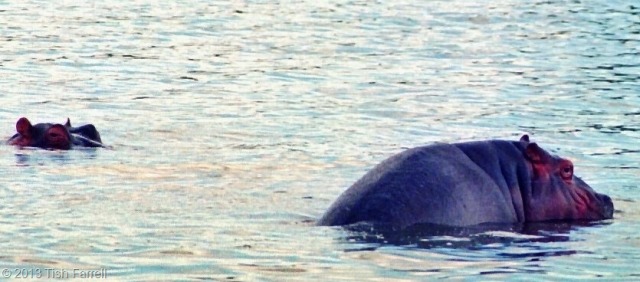
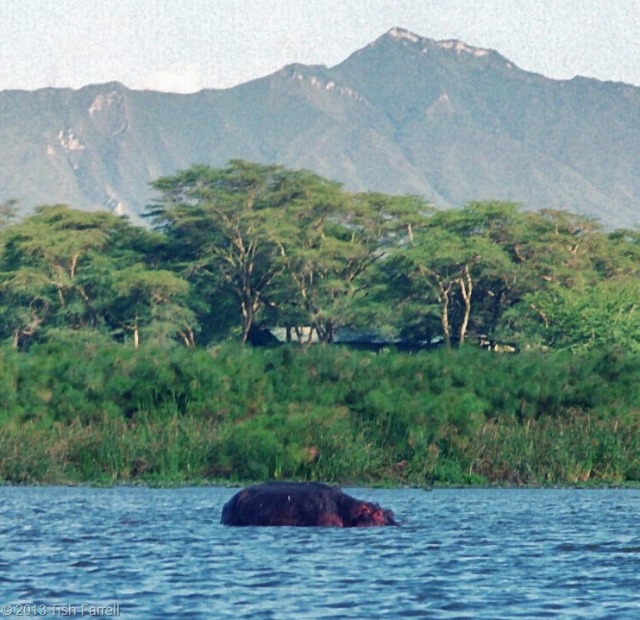

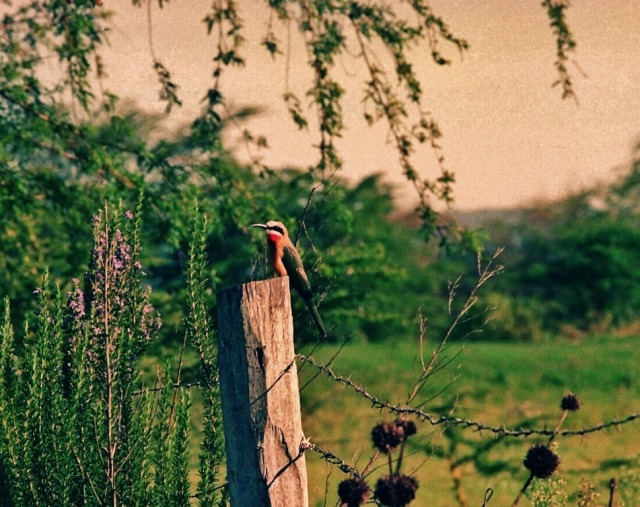
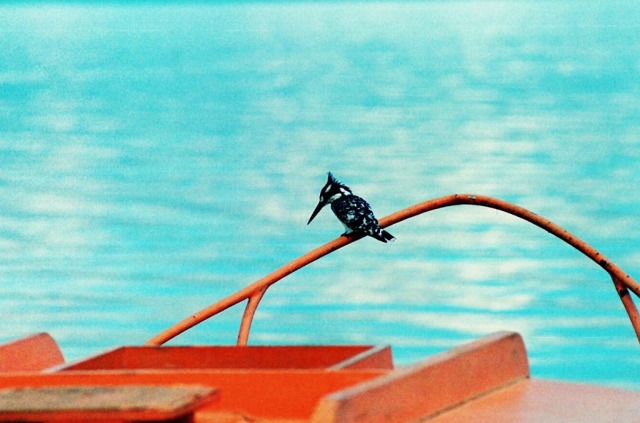

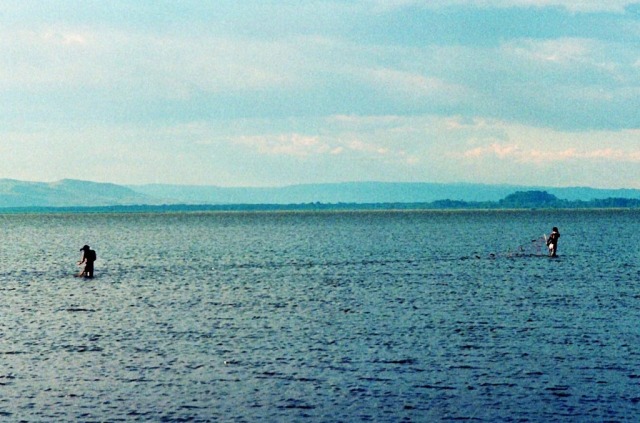
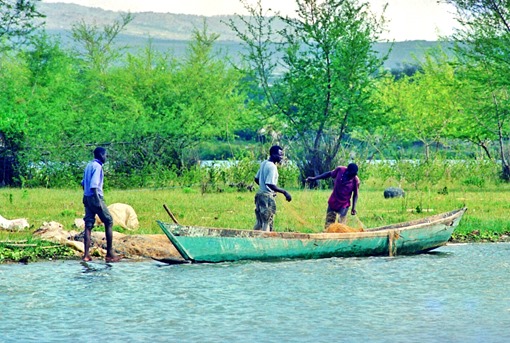

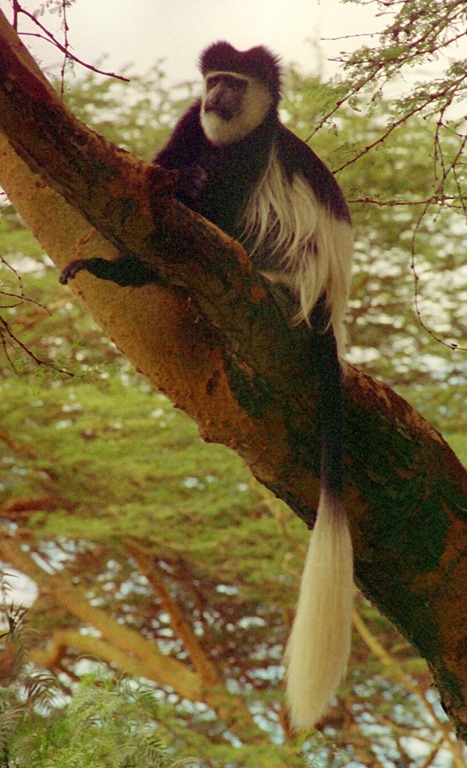


















What a wonderful post Tish. I like how you outlined the conflicting good vs evil and left the questions unresolved. How sad that in trying to do a good thing the US has ruined a critical crop 😦 And the lodge owner–how bizarre! Great shots too!
Lovely comments, Tina. Thank you. Yes, there can be grave consequences in moving crops and animals around the world. The LGB example is only one of many. Another introduced pest across Africa is water hyacinth, which though beautiful, (and probably escaped from a colonial garden) is clogging up waterways like Lake Victoria and also Naivasha. Its impact on fishing and on daily life for rural people is dreadful. Mind you, they’ve found the fibre can make some pretty cool garden furniture.
There were no flower factories when I first visited lake naivasha in 1980. You could drive down to the papyrus at the lakeside and picnic under the fever trees, with Grants and Thompson gazelles grazing nonchalantly nearby. I too saw a Goliath Heron, but it took off as I was focussing and my slide is too blurred to share.
Oh gosh, Ian, I can picture your version of Naivasha so well. Trouble is one ends up with Karen-Blixenitis, thinking of a beautiful, unsullied land. And of course much of that remains. But there are such consequences to all the so-called development, not all of them bad of course. I suppose what annoys me most is that the host countries are not usually equal partners, or else some elite is deriving most of the benefits, when what one wants is grass-roots up, not the odd drip down to the general population.
frizz-comment: I love your storytelling from Africa! compare: flowers in our kitchen: http://www.flickr.com/photos/frizztext/9306964082/
hi Tish, I’ve reblogged your wonderful tribute to Africa via
and there some (German) flowers for you…
Thanks so much, Frizz, for the comments, the reblog and the beautiful garden flowers.
Reblogged this on Flickr Comments and commented:
Hi Tish, frizz-comment: I love your storytelling from Africa! compare: flowers in our kitchen: http://www.flickr.com/photos/frizztext/9306964082/
Thanks for an interesting and lovely post.
Loved to read you post, beautifully told and documented! I miss my “lives” in Africa!
Thank you for your lovely comments. Yes, once in Africa, it’s always there – in your marrow somewhere. It’s the emotional version of having malaria, except it seems to stick in your system.
So true! I definitely have that malaria…
Hi Tish! I have discovered your post thanks to Frizz!!!! And I loved it…
I will stay here for a while!
thanks for dropping by. Frizz is a great bridge between just about everything.
What beautiful countryside and wildlife, thanks for sharing these
I’m inviting you to our Monday photo link-ups called Travel Photo Mondays, come and join us with your beautiful imagery.
Thank you for your very nice comments and for visiting my blog. I’ve just been looking at your delicious mango post and will be back for more.
your photos are lovely, everyone tries to make a living, even under the papyrus bushes!
Thanks, Joan. Yes everyone tries their hardest.
hi Tish,
today is NELSON MANDELA DAY – I’ve just highlighted an article for twitter – though it is in German – maybe you can use a google translate click:
https://twitter.com/frizztext/status/357766077033349120
Hi Frizz, thanks for the link. It is a great article. Mandela, now there is a pathfinder for you!
Very good article, chiming in with my own experience of L.Naivasha.
A conflicted place, so lovely with so many beautiful creatures and also quite scary. We visited it with a friend of the late Joan Root so she had mixed feelings because of Joan’s murder and also because she and her husband had worked for one of the Dutch flower companies for a while and knew about the pollution not only from the horticulture but from the workers who have to camp around the lake. Better to bird watch as you say and we did 🙂
Thanks so much for your comments, Susan. Yes, the human pollution too. Things like water hyacinth that has invaded parts of the lake loves that kind of nutrient cocktail. It was awful about Joan Root’s murder. She made some amazing wildlife footage – e.g. being a sitting duck for a spitting cobra, enticing it to strike!
Great photos to accompany your informative post – love how a little bit of magic got you to weave a story about the larger less magical issues plaguing this paradise…
I’m so glad you liked the post. Thanks for reading.
Every time I visit your blog I’m mesmerized by the beauty of your photographs. Great post!
What a lovely thing to say, Vashti. I’m glad you keep coming!
Thank you for giving us a peek into a world we know little about.
You’re most welcome. I’m learning a lot from your blog too. Good to share, as they say.
Fascinating story and your photos are terrific.
Thanks, Suzanne
a nice post
Boniface is a Real Estate Consutant based in naivasha and focuses on Holiday rentals for naivashahotel in the naivasha Kenya riftvalley. naivasha hotelkenyas riftvalley is famous for holidays and works for Naivasha hotel
Ah … yes … when we wos yung … or younger at least.
There are simply too many of your older posts that I have not read, so it’s nice to click on one every now and then that I had not come across before.
Reading a post like this will often illicit similar feelings of when I first arrived in Johannesburg. I felt so like a fish out of water,yet also full of curiosity, and a huge dollop of naivety.
All said and done though, your posts always make me smile.
That’s so nice to know, Ark – that I make you smile. And very nice of you to read this older post too 🙂
I smiled at the buffalo sign. It reminded me of the time Celeste and I were down in St Lucia by the estuary and we went for a walk and wandered off the path a bit – we stumbled across a duiker which I managed to photograph.
When we got back to our lodgings we were chatting with one of the chaps who worked there about our afternoon and he suddenly went very quiet then said :
”You were walking where? Did no one warn you that crocs regularly come out of the water by that part of the estuary? Didn’t you see the signs?”
”Er ….”
Innocence is bliss as they say. I remember walking alone along a muddy track in the Aberdares, and then becoming aware that beside me were rather fresh looking leopard prints going in my direction, and then thinking that maybe retreat was wiser…
Wow! What a plethora of experiences all parcelled up into one perfect article. Very much enjoyed reading this. An eye opener!
Thanks a lot, Lizzie. Very nice of you to read the whole thing 🙂
Once I started reading I just had to carry on to follow through. You should write a book, Tish.